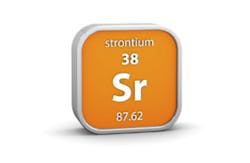Contaminant of the Month: Strontium
What it is:
- Strontium is a silvery alkaline earth metal like calcium and magnesium, but it oxidizes and burns in air.
- It forms water soluble Sr++ salts, such as strontium chloride (SrCl2) and strontium carbonate (SrCO3), by losing two electrons.
- Its atomic number is 38 and it has four stable natural isotopes and 12 mostly short-lived (days) radioactive isotopes.
- The half-life of Sr-90, produced by nuclear plants and detonations, is the longest — 28.9 years; it is present at trace levels in some surface waters from old fallout and catastrophic nuclear plant releases (e.g. Chernobyl).
- Strontium salts burn at very high temperatures with a crimson flame, so they are used in fireworks.
- It is a minor contributor to hard water.
Occurrence:
- Strontium makes up about 0.02 percent of the Earth’s crust, but its salts are detectable in essentially all drinking waters.
- It was found in more than 99 percent of 989 drinking water groundwaters in the 1988 National Inorganics Reconnaissance Survey (NIRS).
- Concentrations ranged from 1 ppb to > 10 ppm with a mean of 0.6 ppm (600 ppb).
- Preliminary results from the current Unregulated Contaminants Monitoring Rule (UCMR 3) had 100 percent detections, including surface and groundwaters, with the 95th percentile at 1.7 ppm (1,700 ppb).
- In the UCMR 3, 1.1 percent of reporting public water systems exceeded the Health Reference Level (HRL 4,000 ppb).
- Dietary exposure estimates are approximately 0.5 to 1.5 mg/day.
Health effects:
- Strontium chemistry is similar to calcium’s chemistry, so it accumulates in bone and can affect bone formation at sufficient doses.
- The EPA Lifetime Drinking Water Health Advisory and HRL were both 4,000 ppb (4 ppm).
- It is not highly toxic, however, there are concerns about excess exposure in the early bone forming years.
- Strontium-based drugs (ranelate) are used in osteoporosis treatments and are also available as over-the-counter supplements.
Water treatment:
- Water softening is effective treatment for strontium.
- Precipitative lime softening with calcium hydroxide and lime-soda ash softening are used by municipal water plants.
- Point-of-entry (POE) softening with a cation exchange resin is common practice.
- Point-of-use (POU) reverse osmosis (RO) softening is another option in the home.
Regulation:
- There are no current health-based regulations for natural strontium.
- Sr-90 is dealt with in radioactivity regulations and is not a general concern because of declining concentrations in water from old nuclear tests.
- On October 20, EPA announced its preliminary intention to regulate strontium, and it changed the HRL of 4,000 ppb to 1,500 ppb by choosing a different rat study and changing the uncertainty (safety) factor to 1,000 from 300.
- It based the decision to regulate on the 1988 NIRS occurrence data rather than the current UCMR3 data.
- Seven percent of NIRS groundwaters exceeded 1,500 ppb and 14.3 percent exceeded half of the HRL. If borne out, the regulatory impact would be significant.
- Monitoring requirements would affect all public water systems, and any health benefits would most likely be small.
- Water softening would provide concurrent benefits.
- A final regulatory determination would probably appear in 2015, proposal in 2017 and final regulation in 2019.
- Some well-designed epidemiology studies would appear to be prudent prior to a regulation. Stay tuned.
Dr. Cotruvo is president of Joseph Cotruvo and Associates, LLC, Water, Environment and Public Health Consultants. He is a former director of the U.S. EPA Drinking Water Standards Division.
